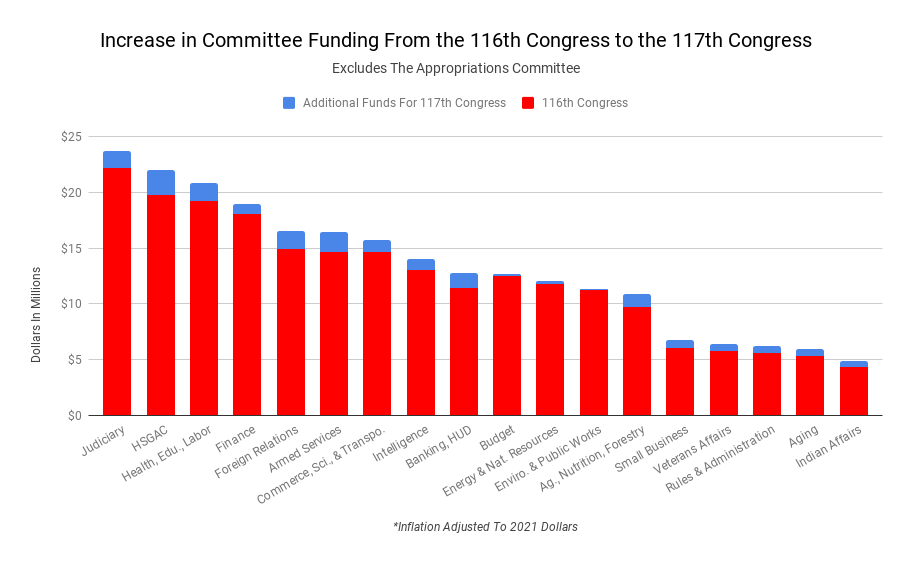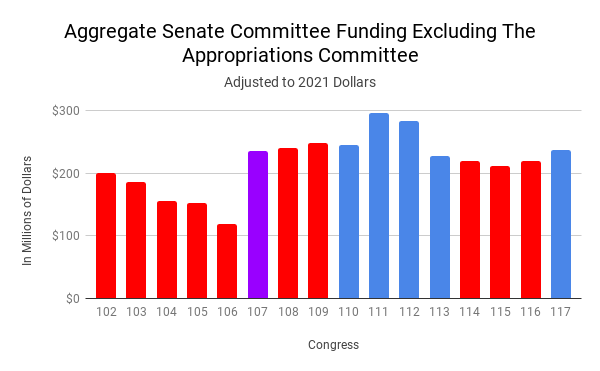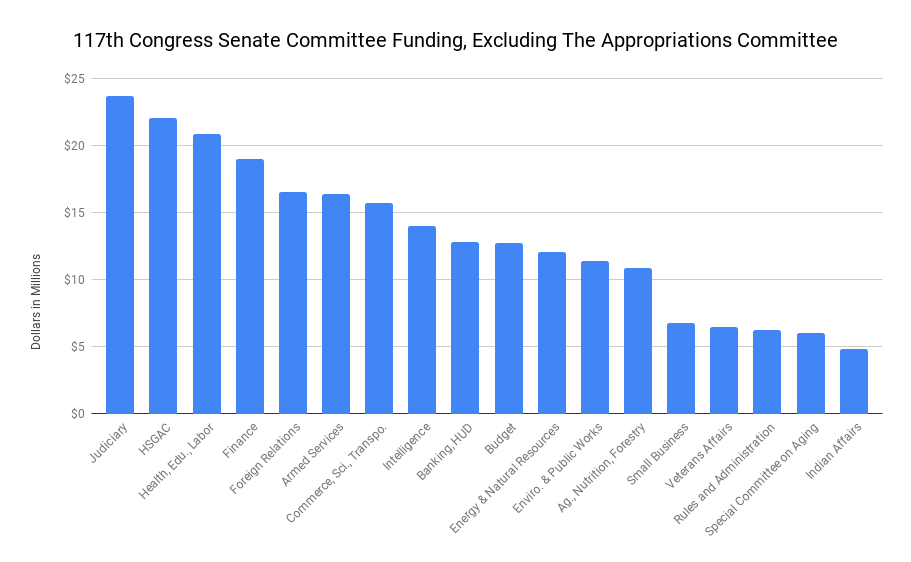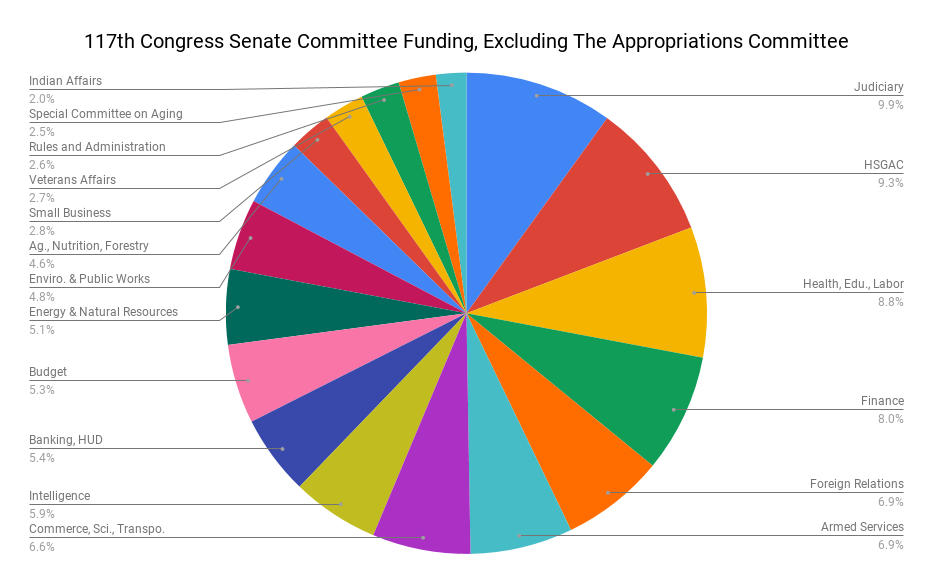Senate committees are at the heart of the legislative process, but what resources are provided for them to do their work? We reviewed the funding levels for Senate committees this Congress as compared to last Congress and over the decades. Here is what we found:
Senate committees are funded at $238.2 million for the 117th Congress. This represents an 8.2% or $18 million increase from last Congress’s $220.2 million funding level. There is an average increase of $1 million or 8.7% per committee.
Senate committee funding is down by $59 million or 19.9% from the 111th Congress, where it peaked at $297.3 million. Funding this Democratically-controlled Congress also falls short of the Republican-controlled 109th Congress, when Senate committees were funded at $248 million.
Half of Senate committees experienced cuts in funding levels between the 107th and 117th Congresses. In addition, just one committee received a 20% increase from 2001 to 2021 — the Intelligence Committee.
(Please note this analysis excludes funding for the Appropriations Committee, which is funded through a separate mechanism, and we are using constant 2021 dollars.)
HOW COMMITTEE FUNDING CHANGED BETWEEN THE 116TH AND 117TH CONGRESSES
Senate committee funding in the Democratically-controlled Senate in the 117th Congress is up across the board compared to the Republican-controlled Senate in the 116th Congress. Between the two congresses, there was a median 11.3% increase per committee, which is $900,140 per committee.

FUNDING FOR SENATE COMMITTEES IN CONTEXT
We used data from this CRS report and our own research to examine total Senate committee funding from 1991 to present. The takeaway? Funding levels this Congress are slowly rising after hitting an 18-year low during the 115th Congress. While this increase is a step in the right direction, the numbers still are nearly $60 million short of their 2010 funding peak, resulting in an overall decline in resources for staff.
The Senate will fund its committees at $238 million in the 117th Congress, excluding the Appropriations Committee. Funding was at its highest during the Democratically-controlled 111th Congress, totaling $297.3 million (again excluding the Appropriations Committee). By contrast, the Senate funded committees at 40% of that amount during the Republican-controlled 106th Congress, for a total of $119.1 million (excluding the Appropriations Committee).

FUNDING PER COMMITTEE
Among the committees for which funding data is available, Judiciary and HSGAC have the largest budgets, at $23.7 million and $22.0 million respectively. Median Senate committee funding for the 117th Congress is $12.7 million. You can see committee funding levels in the charts below:


CHANGES IN COMMITTEE FUNDING OVER TWO DECADES
We compared committee funding for the 117th Congress against funding levels 20 years ago, in the 107th Congress. Over that time, half of the Senate committees experienced funding cuts. Only the Select Committee on Intelligence experienced a significant funding increase.
Which committees had the most significant funding increases? Funding for the Select Committee on Intelligence increased by $4.2 million or 43%, which is the largest increase of any committee. Veterans Affairs had the second largest percentage increase — $1.1 million or 20%, and Finance saw the second largest dollar increase — $2 million or 11.8%. Judiciary, the highest funded committee, saw a $1.5 million or 6.6% increase.
Which committees had the most significant funding decreases? The two smallest committees, Indian Affairs and Aging, saw cuts of $231,506 or 4.6% and $529,322 8.1% respectively. The Budget Committee, however, took the biggest hit in dollar and percentage terms: a $2.4 million or 16% cut from 2001 to 2021.

WHAT DOES ALL THIS MEAN?
The Senate majority flipped at the beginning of the 117th Congress. With a Democratic majority at the helm, the 117th Senate has begun to restore overall committee funding levels. However, current funding is well below 2010 levels, as well as 2005 levels which were set by a Republican majority.
THE SENATE COMMITTEE FUNDING PROCESS
Senate committees get their funding through a two-step process: authorization and appropriation.
At the beginning of each new Congress, nearly all committees submit funding resolutions to the Senate Committee on Rules and Administration (Rules Committee); some committee chairs and ranking members supplement the resolutions with testimony before the committee. The Rules Committee then drafts a resolution that authorizes the committee to spend money, which is passed by the Senate. (It can be an omnibus, like this, or there can be multiple resolutions.) Note, however, that the Senate Appropriations Committee is not subject to this authorizing process, and its funding is directly appropriated in the appropriations bill. (For an example, see line 14 of page 3.)
The Rules Committee sets a ceiling on how much money each committee that it authorizes funding for may access during designated calendar periods: March 1 to September 30 of the first year of a Congress, October 1 to September 30 of the following year, and from October 1 to end of the following February.
Appropriations for committee funding occur annually prior to the start of the fiscal year on October 1. The Legislative Branch appropriations subcommittee appropriates a lump sum of money for all Senate committees (except for the appropriations committee and conference committees, which are provided for separately).
It’s important to note that these two cycles, authorization and appropriations, operate on two entirely different calendars. Committee authorizations are usually for two years and the resolution is usually passed by March 1. The appropriations cycle usually takes place prior to the start of the fiscal year on October 1.
The Legislative Branch appropriations subcommittee generally does not dictate funding levels for each individual committee — that happens through the committee authorization process, described above — nor does it govern how funding for staff will be divided between the majority and minority. The division of staff between majority and minority is governed by Senate Rule XXVII, and reflects the relative majority and minority composition of the committee.
To check our work, you can access the un-adjusted committee funding data from 1991-2021 and the inflation adjusted committee funding data from 1991-2021.
(This is an update of the 2019 and 2020 articles on how Senate committees are funded, containing new information for the 117th Congress.)